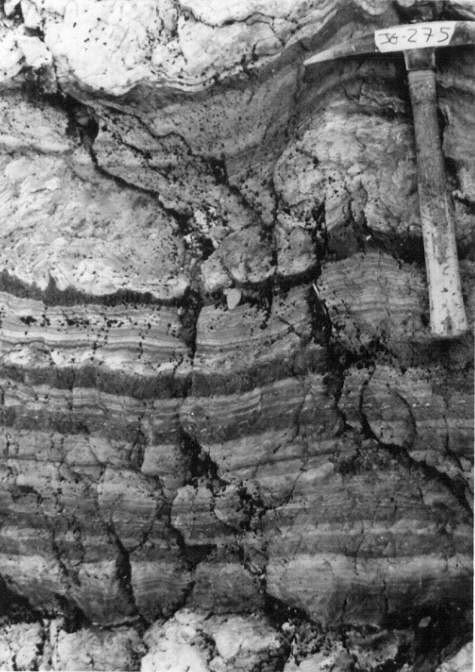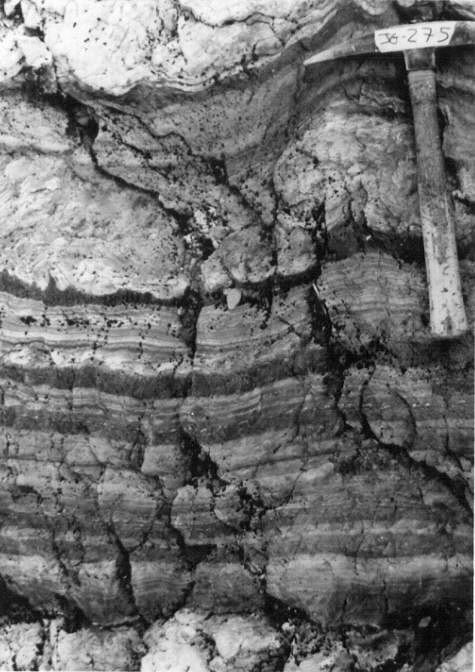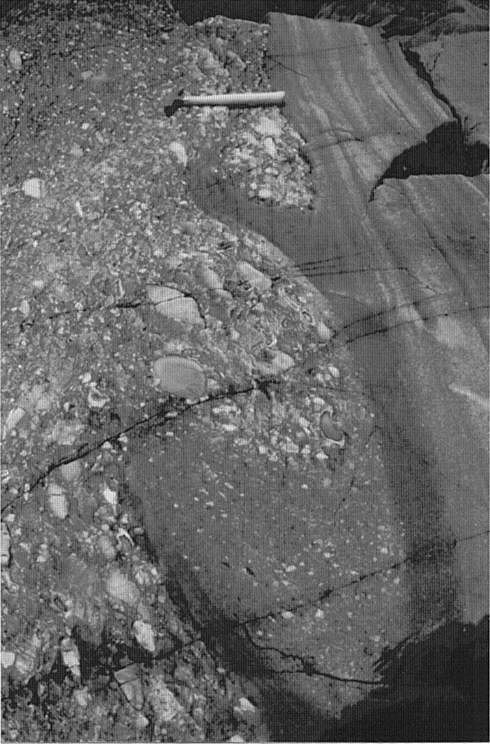
DISCLAIMER: This English version is translated from the original French. In case of any discrepancy, the French version shall prevail.
| Author(s): | Sauvé and Bergeron, 1965 |
| Age: | Paleoproterozoic |
| Stratotype: | None |
| Type area: | Baby Lake area (NTS sheet 24K05, UTM NAD83, zone 19 : 455021 m E, 6458656 m N) |
| Geological province: | Churchill Province |
| Geological subdivision: | New Quebec Orogen (Labrador Trough)/Gerido, Howse and Mélèzes lithotectonic zones |
| Lithology: | Sedimentary rocks, basalt, tuff, breccia |
| Category: | Lithostratigraphic |
| Rank: | Inapplicable |
| Status: | Informal |
| Use: | Active |
Background
Sauvé and Bergeron (1965) used the informal name « Lower Phyllites » to designate a unit of mudstone, phyllite and schist accompanied by numerous quartzite beds near the top, forming the lower part of the Baby Formation. Subsequently, different terms have been used to refer to it, namely Lower member of the Baby Formation (Clark, 1988; Wares et al., 1988; Wares and Goutier, 1989, 1990; Goutier and Wares, 1991); Lower Baby unit or Lower Baby (Goulet, 1995; Clark and Wares, 2004), Lower Baby Formation (Clark and Wares, 2004, Figure 33, page 55; Clark, 2019). In this compilation, the lower member of the Baby Formation is referred to as the Lower Baby member.
Authors who have contributed to the description of the various units of the Lower Baby member include Bergeron (1953, 1956), Sauvé (1955, 1956a, 1956b, 1959), Freedman and Philpotts (1958), Bérard (1959, 1965), Hashimoto (1964), Fahrig (1965), Clark (1977, 1978, 1979, 1980), Dressler (1979), Bélanger (1982) and Goulet (1995). The Larch River Formation (now abandoned) was considered to be partly equivalent to the Lower Baby member (Clark and Wares, 2004).
Description
The Lower Baby Member is an allochthonous volcano-sedimentary unit forming the lower part of the Koksoak Group (Clark and Wares, 2004). It is represented by alternating mudstone, siltstone and sandstone displaying a rhythmic structure as well as quartzitic sandstone (turbidites). The Lower Baby member is generally identical to the Upper Baby member. It differs from the latter only in its stratigraphic position relative to dolomites of the Denault Formation (formerly Abner Formation) and iron-bearing rocks of the Middle Baby member (Sauvé and Bergeron, 1965; Wares and Goutier, 1990).
The Lower Baby member comprises seven informal units:
- Mudstone, siltstone and some sandstone (pPbb(i)1);
- Quartzitic sandstone interbedded with mudstone and dolomite, and quartzite (pPbb(i)2);
- Basalt, pillow basalt, tuff and breccia (pPbb(i)3);
- Dolomite (pPbb(i)4);
- Graphitic black slate, locally pyritic, silty slate and grey, dark grey or greenish grey siltstone (pPbb(i)5);
- Micaceous schist and phyllite interbedded with quartzite and conglomerate (pPbb(i)6);
- Biotite micaceous schist, chlorite schist and biotite metapelite (pPbb(i)7). This last unit may include minor amounts of marble, carbonatized metapelite, quartzite or sandstone.
The rocks of the Lower Baby member are generally metamorphosed to the greenschist facies (Dimroth and Dressler, 1978; Fraser et al., 1978). These sedimentary rocks were deposited in a marine basin, located east of the Ferriman Group platform sequence, which was gradually deepening from west to east (Clark and Wares, 2004). In the northern part of the Labrador Trough, the presence of conglomerate and volcanic rocks near the base of the unit suggests that it was deposited while the basement was extending (Goulet, 1995).
The Lower Baby member locally contains syngenetic polymetallic massive sulphide mineralization (Zn-Pb-Cu-Ag-Au) hosted in rhythmites (Wares and Berger, 1987; Wares et al., 1988; Clark and Wares, 2004).
Lower Baby member 1 (pPbb(i)1): Mudstone, Siltstone, Some Sandstone
Unit pPbb(i)1 forms a sequence of mudstone, siltstone and lesser amounts of interbedded sandstone characterized by a rhythmic structure (rhythmites). These rocks are grey to dark greenish grey in fresh surface and slightly less dark in altered surface. They occur in millimetre to centimetre-thick (0.5-5 cm) finely laminated beds (Sauvé and Bergeron, 1965; Clark, 1977, 1978, 1979, 1980; Dressler, 1979). Sedimentary structures include sorting, parallel and cross bedding (Sauvé and Bergeron, 1965; Wares et al., 1988). Mudstone is fissile and locally graphitic. In places, it has a rusty alteration patina due to the presence of pyrite (Hashimoto, 1964; Clark, 1979; Dressler, 1979). The rock is locally schistose and occurs as phyllites and schists. Siltstone and sandstone are fine grained (Clark, 1977, 1979). Very thick (>4 m) sorted and channelized sandstone beds are present in places. Oblique stratification is also observed (Goulet, 1995). In the area NW of Gerido Lake, the upper part of unit pPbb(i)1 is locally thinly interbedded with quartzite (Sauvé, 1956; Sauvé and Bergeron, 1965). The rocks of this unit were referred to as the (now abandoned) Larch River Formation (Clark, 1978, 1979).
Lower Baby member 2 (pPbb(i)2): Quartzitic Sandstone, Interbedded Mudstone and Dolomite; Quartzite
Unit pPbb(i)2 consists of grey, fine to medium-grained, bedded quartzitic sandstone. Sandstone beds are 1 to 3 m thick. They are interbedded with mudstone and, less frequently, dolomite (Clark, 1979). In the Feuilles Lake area (sheets 24K13 and 24N04), unit pPbb(i)2 consists of quartzitic sandstone and quartzite (Freedman and Philpotts, 1958; Sauvé, 1959; Bérard, 1965). The rock is white, grey or light yellow in fresh surface and white in altered patina. It is composed of quartz (75%), plagioclase (7%), muscovite (5%), biotite (3%), calcite (3%), dolomite (2%), chlorite (2%) and minor amounts of phlogopite and pyrite. Accessory minerals are apatite, stilpnomelane, tourmaline and zircon. In thin sections, quartz is granoblastic and has an undulatory extinction. It contains rare inclusions of chlorite, sericite, biotite, zircon and plagioclase. Plagioclase (albite) is granoblastic, twinned and locally pœikloblastic. Muscovite, biotite and chlorite are found between quartz grains (Bérard, 1965).
Lower Baby member 3 (pPbb(i)3): Basalt, Pillow Basalt, Tuff, Breccia
Unit pPbb(i)3 consists of basalt, tuff and breccia (Hashimoto, 1964; Clark, 1978; Bélanger, 1982; Goulet, 1995). These rocks are mainly basaltic in composition. They are grey to greenish grey or dark green to black, fine grained, and in places have a brownish altered patina. Basalt occurs as massive pillowed flows, locally interstratified with mafic tuff layers. In the Pyrite Falls area (sheet 24F06), basalt is locally vesicular (Clark, 1978). Further north, in the Faujas Lake area (sheet 24K05), pillow volcanic rocks contain highly deformed pillows, generally decimetric in size, whose polarity cannot be determined (Bélanger, 1982). SW of Raymond Lake (sheet 24K13), the flows are relatively thin (<10 m). They are massive at the base and pillowed with flow breccia at the top. Lavas are commonly porphyritic at the base of the unit and contain feldspar phenocrysts up to 2 cm in diameter. Each flow is typically overlain by mafic crystal tuff and laminated tuff (Goulet, 1995). Basalt is mainly composed of chlorite and albite with minor amounts of calcite. Near Jogues Lake, it locally contains 2-3% magnetite as well as epidote (Hashimoto, 1964).
Lower Baby member 4 (pPbb(i)4): Dolomite
Unit pPbb(i)4 consists of three small strips (1-2 km long) of dolomite located in the areas east of Jogues and Aulneau lakes (Dressler, 1979).
Lower Baby member 5 (pPbb(i)5): Graphitic Black Slate, Locally Pyritic; Silty Slate; Grey, Dark Grey or Greenish Grey Siltstone; Rusty Quartz Veinlets
Unit pPbb(i)5 consists mainly of graphitic black slate, locally pyritic, silty slate and grey, dark grey or greenish grey siltstone (Bérard, 1965; Sauvé and Bergeron, 1965; Clark, 1978, 1979, 1980, 1988). In places, these rocks have a rusty surface due to the presence of disseminated pyrite. Slate is commonly interbedded with millimetric beds of fissile siltstone, which may be locally pyritic. It also contains rusty quartz veinlets parallel to bedding (Clark, 1978, 1979). The rocks of this unit are highly deformed and affected by folding and thrust faults east of the Gourdon and Dusay lakes (Bérard, 1965).
Lower Baby member 6 (pPbb(i)6): Micaceous Schist and Phyllite; Interbedded Quartzite and Conglomerate
Unit pPbb(i)6 consists of micaceous schist and phyllite interbedded with quartzite and conglomerate (Bérard, 1959; Sauvé, 1959). Schist is composed of biotite, muscovite and chlorite (Sauvé, 1959). Variable amounts of garnet may be present locally (Clark, 1978). Quartzite occurs in metre-thick beds. It is generally quite pure, but may contain significant amounts of chlorite and muscovite. Conglomerate forms centimetre to metre-thick beds or lenses. It is composed of subrounded pebbles, 1 to 7 cm in diameter, sedimentary rocks (chert, quartzitic arenite, dolomite, sandstone, mudstone), volcanic rocks and plutonic rocks (Archean bedrock) in a sandstone matrix (Sauvé, 1959; Goulet, 1995). In the area north of Feuilles Lake, conglomerate is channelized (Goulet, 1995).
Lower Baby member 7 (pPbb(i)7): Biotite Micaceous Schist, Chlorite Schist, Biotite Metapelite; May Include Some Marble, Carbonatized Metapelite, Quartzite or Sandstone
Unit pPbb(i)7 consists mainly of biotite micaceous schist, chlorite schist and biotite metapelite (Bérard, 1959, 1965; Sauvé, 1959; Clark, 1978). These rocks are green, grey or black, fine to medium grained, with well-developed schistosity. In places, a remnant of primary bedding is marked by the presence of thin sandstone beds. Schists contain numerous biotite and albite porphyroblasts that give the rock a spotted appearance (Bérard, 1959, 1965). The unit may include smaller amounts of marble, carbonate metapelite, quartzite or sandstone (Bérard, 1965; Sauvé, 1959; Clark, 1978).
In thin sections, rocks of this unit are mainly composed of quartz, biotite, chlorite, sericite and albite in variable amounts. Accessory minerals are apatite, microcline, epidote, stilpnomelane, tourmaline, cordierite, calcite, zircon, graphite, magnetite, pyrite and sphene. Quartz has a characteristic granoblastic texture. It occurs as grains 0.05 to 1.5 mm in diameter having an undulatory extinction. Biotite has a lepidoblastic or porphyroblastic texture. Porphyroblasts vary in diametre from 0.5 to 3 mm. Chlorite is generally lepidoblastic, rarely porphyroblastic. Albite has a granoblastic texture. It occurs as 0.3 to 1.5 mm crystals and forms porphyroblasts 1.5 to 2 mm in diameter. Muscovite is abundant in all rocks and is associated with biotite and chlorite. It exhibits a lepidoblastic texture resulting from sericite recrystallization (Bérard, 1965). The presence of garnet is also reported (Bérard, 1965; Clark, 1978).
Thickness and Distribution
The Lower Baby member belongs to the Gerido, Howse and Larch lithotectonic zones, as defined by Clark and Wares (2004). It extends ~250 km from Feuilles Lake (sheet 24K13) to Aulneau Lake (sheets 24C15 and 24F02). Sauvé and Bergeron (1965) estimate its thickness to be ≥600 m in the Gerido and Thévenet lakes area. However, with the exception of the Oatmeal and Baby lake margins, the member outcrops sparsely and is strongly folded in this area. In the Feuilles Lake area, near Algerine Pass (sheet 24K13), Goulet (1995) estimates a thickness of ~795 m. In the area SW of Hellancourt Lake (sheet 24K04), Goutier and Wares (1991) measured a minimum thickness of 300 m.
Dating
None.
Stratigraphic Relationship(s)
The Lower Baby member is Paleoproterozoic in age. It belongs to the second Labrador Trough sedimentation cycle dated 1.88 to 1.87 Ga (Clark and Wares, 2004). The Lower Baby member correlates with the Ruth Formation, which underlies the Sokoman Formation (1880 ±2 Ma; Chevé and Machado, 1988), and is therefore the same age as the Ruth Formation and slightly older than the Sokoman Formation.
The Lower Baby member conformably overlies dolomite of the Denault Formation (Attikamagen Group) and is conformably overlain by iron formation of the Middle Baby member. At the base, it is in gradual or interbedded contact over a few metres with the underlying Denault Formation (Bérard, 1965; Sauvé and Bergeron, 1965; Clark, 1978, 1988; Wares et al., 1988; Clark and Wares, 2004). In places, Goulet (1995) points out that the contact between the Lower Baby member and the Denault Formation is faulted. At the top, the Lower Baby member is in sharp contact with the Middle Baby member (Sauvé and Bergeron, 1965; Clark, 1978, 1979; Goulet, 1995).
In the northern Labrador Trough, the Lower Baby member is equivalent to the Wishart and Ruth formations (Ferriman Group) located further west (Goulet, 1995; Clark and Wares, 2004).
Paleontology
Does not apply.
References
Publications Available Through SIGÉOM Examine
BELANGER, M. 1982. REGION DU LAC FAUJAS, NOUVEAU-QUEBEC. MRN. DP-82-06, 1 plan.
BERARD, J. 1959. PRELIMINARY REPORT ON LEAF LAKE AREA, NEW QUEBEC. MRN. RP 384(A), 8 pages and 1 plan.
BERARD, J. 1959. RAPPORT PRELIMINAIRE SUR LA REGION DU LAC AUX FEUILLES, NOUVEAU-QUEBEC. MRN. RP 384, 10 pages and 1 plan.
BERARD, J. 1965. BERARD LAKE AREA, NEW QUEBEC. MRN. RG 111(A), 148 pages and 2 plans.
BERARD, J. 1965. REGION DU LAC BERARD, NOUVEAU-QUEBEC. MRN. RG 111, 175 pages and 2 plans.
BERGERON, R. 1953. PRELIMINARY REPORT ON GERIDO LAKE AREA, NEW QUEBEC. MRN. RP 291(A), 8 pages and 1 plan.
BERGERON, R. 1953. RAPPORT PRELIMINAIRE SUR LA REGION DU LAC GERIDO, NOUVEAU-QUEBEC. MRN. RP 291, 10 pages and 1 plan.
BERGERON, R. 1956. RAPPORT PRELIMINAIRE SUR LA REGION DU LAC HARVENG (MOITIE OUEST), NOUVEAU-QUEBEC. MRN. RP 320, 9 pages and 1 plan.
BERGERON, R. 1956. PRELIMINARY REPORT ON HARVENG LAKE AREA, (WEST HALF), NEW QUEBEC. MRN. RP 320(A), 6 pages et 1 plan. LARK, T. 1977. GEOLOGY OF THE FORBES LAKE AREA (NOUVEAU-QUEBEC). MRN. DPV 452, 19 pages and 1 plan.
CLARK, T. 1978. REGION DU LAC HERODIER ( NOUVEAU-QUEBEC) – RAPPORT PRELIMINAIRE. MRN. DPV 568, 48 pages and 2 plans.
CLARK, T. 1979. REGION DU LAC NAPIER (NOUVEAU-QUEBEC) – RAPPORT PRELIMINAIRE. MRN. DPV 663, 28 pages and 1 plan.
CLARK, T. 1980. REGION DE LA RIVIERE KOKSOAK (NOUVEAU-QUEBEC) – RAPPORT PRELIMINAIRE. MRN. DPV 781, 24 pages and 1 plan.
CLARK, T. 1987. STRATIGRAPHIE, PETROGRAPHIE ET PETROCHIMIE DE LA FORMATION DE FER DE BABY DANS LA REGION DU LAC HERODIER (FOSSE DU LABRADOR). MRN. ET 87-13, 44 pages.
CLARK, T., 2019. Compilation géologique, lac Harveng. MERN; CG-2019-01, 1 plan.
CLARK, T., WARES, R. 2004. SYNTHESE LITHOTECTONIQUE ET METALLOGENIQUE DE L’OROGENE DU NOUVEAU-QUEBEC (FOSSE DU LABRADOR). MRNFP. MM 2004-01, 182 pages and 1 plan.
DRESSLER, B., CIESIELSKI, A. 1979. Région de la fosse du Labrador. MRN. RG 195, 136 pages and 14 plans.
FREEDMAN, R O., PHILPOTTS, J A. 1958. REPORT ON RED DOG LAKE AREA (UNGAVA). MRN. DP 049, 13 pages and 1 plan.
GOULET, N. 1995. ETUDE STRUCTURALE, STRATIGRAPHIQUE ET GEOCHRONOLOGIQUE DE LA PARTIE NORD DE LA FOSSE DU LABRADOR. MRN. MB 95-36, 41 pages and 1 plan.
GOUTIER, J., WARES, R. 1991. GEOLOGIE DU SECTEUR DE L’INDICE AURIFERE DESSUREAULT, FOSSE DU LABRADOR – RAPPORT INTERIMAIRE. MRN. MB 91-10, 20 pages and 2 plans.
HASHIMOTO, T. 1964. GEOLOGIE DE LA REGION DU LAC JOGUES, TERRITOIRE DU NOUVEAU-QUEBEC. MRN. RP 524, 13 pages and 1 plan.
SAUVE, P. 1955. RAPPORT PRELIMINAIRE SUR LA REGION DU LAC GERIDO (PARTIE EST), NOUVEAU-QUEBEC. MRN. RP 309, 10 pages and 1 plan.
SAUVE, P. 1955. PRELIMINARY REPORT ON GERIDO LAKE AREA (EAST HALF), NEW QUEBEC. MRN. RP 309(A), 7 pages and 1 plan.
SAUVE, P. 1956. RAPPORT PRELIMINAIRE SUR LA REGION DU LAC DE FRENEUSE (MOITIE OUEST), NOUVEAU-QUEBEC. MRN. RP 332, 10 pages and 1 plan.
SAUVE, P. 1956. PRELIMINARY REPORT ON DE FRENEUSE LAKE AREA (WEST HALF), NEW QUEBEC. MRN. RP 332(A), 7 pages and 1 plan.
SAUVE, P. 1956. RAPPORT PRELIMINAIRE SUR LA REGION DU LAC LEOPARD (MOITIE EST), NOUVEAU-QUEBEC. MRN. RP 325, 10 pages and 1 plan.
SAUVE, P. 1956. PRELIMINARY REPORT ON LEOPARD LAKE AREA (EAST HALF), NEW QUEBEC. MRN. RP 325(A), 7 pages and 1 plan.
SAUVE, P. 1959. RAPPORT PRELIMINAIRE SUR LA REGION DE LA BAIE AUX FEUILLES, NOUVEAU-QUEBEC. MRN. RP 399, 15 pages and 1 plan.
SAUVE, P. 1959. PRELIMINARY REPORT ON LEAF BAY AREA, NEW QUEBEC. MRN. RP 399(A), 11 pages and 1 plan.
SAUVE, P., BERGERON, R., 1965. REGION DES LACS GERIDO ET THEVENET, NOUVEAU-QUEBEC. MRN; RG 104, 141 pages, 3 plans.
SAUVE, P., BERGERON, R., 1965. GERIDO LAKE – THEVENET LAKE AREA, NEW QUEBEC. MRN; RG 104(A), 131 pages, 3 plans.
ARES, R., BERGER, J. 1987. SYNTHESE METALLOGENIQUE DES INDICES DE SULFURES AU NORD DU 57e PARALLELE – FOSSE DU LABRADOR. I R E M. MB 87-19, 15 pages and 1 plan.
WARES, R., BERGER, J., ST-SEYMOUR, K. 1988. SYNTHESE METALLOGENIQUE DES INDICES DE SULFURES AU NORD DU 57e PARALLELE (ETAPE 1) – FOSSE DU LABRADOR -. I R E M. MB 88-05, 202 pages and 1 plan.
WARES, R., GOUTIER, J., 1990. SYNTHESE METALLOGENIQUE DES INDICES DE SULFURES AU NORD DU 57e PARALLELE – FOSSE DU LABRADOR – RAPPORT INTERIMAIRE – ETAPE III. IREM-MERI. MB 90-25, 104 pages and 2 plans.
Other Publications
CHEVÉ, S.R., MACHADO, N., 1988. Reinvestigation of the Castignon Lake carbonatite complex, Labrador Trough, New Québec. Joint Annual Meeting of the Geological Association of Canada and the Mineralogical Association of Canada, St. John’s, Newfoundland; Program with Abstracts, volume 13, page 20.
DIMROTH, E., DRESSLER, B., 1978. Metamorphism of the Labrador Trough. In: Metamorphism in the Canadian Shield. Geological Survey of Canada; Paper 78-10, pages 215-236. https://doi.org/10.4095/104534
FAHRIG, W.F., 1965. Geology, Lac Herodier, Québec. Geological Survey of Canada; Map 1146A. https://doi.org/10.4095/107520
FRASER, J.A., HEYWOOD, W.W., MAZURSKI, M.A., 1978. Carte métamorphique du Bouclier Canadien. Geological Survey of Canada; Map 1475A. https://doi.org/10.4095/133909
Suggested Citation
Ministère de l’Énergie et des Ressources naturelles (MERN). Lower Baby member. Quebec Stratigraphic Lexicon. https://gq.mines.gouv.qc.ca/lexique-stratigraphique/province-de-churchill/membre-de-baby-inferieur_en [accessed on Day Month Year].
Contributors
|
First publication |
Charles St-Hilaire, GIT, M.Sc. charles.st-hilaire@mern.gouv.qc.ca; Thomas Clark, P. Geo., Ph.D. (redaction) Mehdi A. Guemache, P. Geo., Ph.D. (coordination); Claude Dion, Eng., M.Sc. (critical review); Simon Auclair, P. Geo., M.Sc. (editing); Céline Dupuis, P. Geo., Ph.D. (English version); André Tremblay (HTML editing). |



